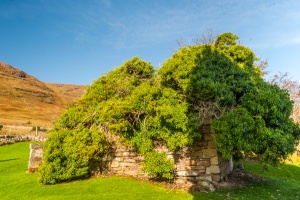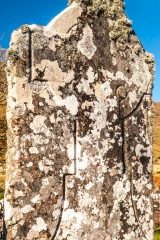Applecross
Associated Chapels: Eilean Mor {NGR NG 696347}; Camusterrach {NGR NG 711417}; Coire {NGR NG 862573}; Annat {NGR NG 898547}.
Parish Church: OS Ref: NGR NG 713458 H.E.S. No: NG74NW 7 Dedication: St Maelrubhe
In ancient times also known as Combric-Abrich and Crosain.
In 673AD St Maelruba (St Malrube, "the Red Priest", etc.), whose festival is 27th August, founded the church of Aporcrossan. The Irish Annals also say that he died there on 21 April 722, aged 80 years, 3 months, 19 days [Annals of Tigernach] having been ab for fifty-one years. There is a story of him dying of wounds received from the Danes. Maelrubha made Aporcrossan the centre of influence throughout a wide district. The sanctuary of Applecross extended for 6 miles all round, and came to be known in Gaelic as A'Chomraich.
Maelrubha was succeeded by Failbe McGuaire who in AD737 perished at sea along with twenty-two followers.
The church stood at the head of the bay on the West side of the parish. It was a 'common church' of the Chapter of Fortrose. There was also a chaplainry, dedicated to St Maelrubha, within the church served by one or two chaplains. In the vicinity are Saint Ruffus Island, Lochan t-Sagairt {NGR NG 740377}, and Island-na-naugh (Saint's Island or Holy Island) {NGR NG 702412}, all remnants from the early days of St Maelrubha's mission here.
In 1549 the Queen was patron of the Church 'pleno jure'. Its patrimony was: Bonnadell; Longoll & Achechork; Kippech; Satrell & Drumloy; Cowlmoir; Corchirie; Coulnakill (Callakill?); Ardestang; Scheildag {NG 815537}; Dybege (Diabaig) {NG 796603}; Rischill (Rassal?) {NG 842428}; Lestang.
The present kirk was built in 1817 but it stands on the site of a much older building, and that, in turn, was founded near the 7th century muinntir.
Very obvious to visitors is the large carved cross just inside the churchyard gate - 'Cloch Mhor Mac Cuagan', 'Cloch Ruainidh Mac Caoigen' or 'Cloch Ruainidh mhoir Mhic Caoigean' is a slab with an incised cross on its south face. It stands 9'3" high, 2'10" broad and 2¾" thick. Reeves (W Reeves 1862) believed that it was the cross of Mac Oigi, Abbot of Bangor and formerly of Applecross, who died in 801. Local tradition says it formerly stood near the mouth of the river, and marked the grave of an ancient chief, Ruairidh Mor Mac Caoigen.
On Eilean Mor, on a small plateau 50ft above and the W of 'Camus na h-Annait' at NG 6964 3472, there are the remains of a building and enclosure. This is supposed to have been an ancient chapel site. The name 'Port na h'Annaide' on the island also suggest an ancient chapel or burying-ground.

Above: Ruins of the 15th-century Chapel at Applecross. ©David Ross and Britain Express

Above: MacAogan's Cross. ©David Ross and Britain Express
It is to be hoped that, one day, the people of Scotland will come to accept the incredible influence Applecross had on the spread of Christianity throughout the land. It can be considered to have been very much of the same importance as the much-celebrated Iona.

e-mail: admin@cushnieent.com
© 2019 Cushnie Enterprises